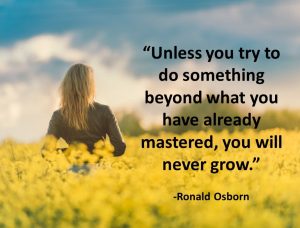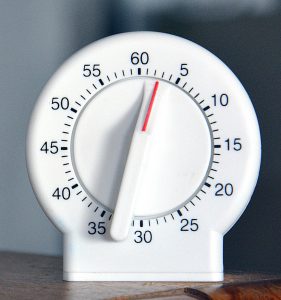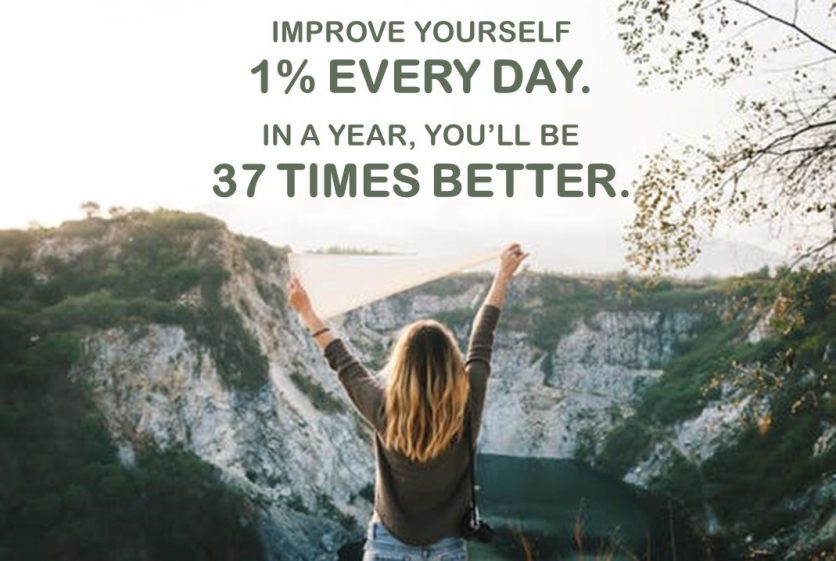September is Self-Improvement Month. What’s the one thing — that if you were to improve by 1% a day for the next 12 months — would make a significant positive shift in your life?
I’m quite fond of the Kaizen method. Kaizen is a Japanese word that means “continuous improvement.” Imagine if you just made a 1% improvement each day toward an important goal? The compound effect of that over time becomes significant.
When you improve a little each day, eventually big things occur. When you improve conditioning a little each day, eventually you have a big improvement in conditioning. Not tomorrow, not the next day, but eventually a big gain is made. Don’t look for the big, quick improvement. Seek the small improvement one day at a time. That’s the only way it happens – and when it happens, it lasts. -John Wooden
The idea is to start small…really small.
Do you want to begin an exercise habit? Start with a one-minute brisk walk today. Tomorrow, add another minute to that. Each day, add another minute. A month from now, you’ll be walking 30 minutes a day.
 Have you always wanted to meditate but just can’t stay focused? Begin with one minute of breathing exercises. Tomorrow, add another minute. The next day, add another minute. Over time you will condition yourself to maintain a meditative state for a longer period of time.
Have you always wanted to meditate but just can’t stay focused? Begin with one minute of breathing exercises. Tomorrow, add another minute. The next day, add another minute. Over time you will condition yourself to maintain a meditative state for a longer period of time.
Perhaps you’d like to establish an evening routine that supports several healthy habits you want to create. Start small by concentrating on the last 10 minutes before you go to bed, building on good habits you already have established. Plan what you’ll do during those 10 minutes: brush and floss your teeth for 3 minutes, read something inspirational for 5 minutes, write in your gratitude journal for 2 minutes. Make these things a habit. Each evening, add 5 more minutes and include another activity you’d like to add to your routine. Over time, you’ll create a satisfying evening routine that supports your priorities and becomes a habit.
 Think of a goal or intention that you’ve been putting off because it has felt too big or too out-of-reach for you. What if you were to identify something small that you could do, and do just a little bit each day? When you break it down into small steps and manageable mini-goals, does it feel more attainable?
Think of a goal or intention that you’ve been putting off because it has felt too big or too out-of-reach for you. What if you were to identify something small that you could do, and do just a little bit each day? When you break it down into small steps and manageable mini-goals, does it feel more attainable?
It’s time to decide what you want. Then make a plan to achieve it!
Two Key Factors: Persistence and Consistency
As you think about improving something by one percent each day, there are two related factors that come into play that are very important to the process of improvement. They are persistence and consistency. I think of these as two sides of the same coin. Persistence is defined as “firm continuance in a course of action in spite of difficulty or opposition,” and consistency is defined as “conformity in the application of something.”
When you do the following seven things persistently and consistently, you’ll find it much easier to accomplish your goals.
- Make your goals specific and measurable and put it in writing. For example, “I weigh 140 pounds on December 31, 2019,” is specific and measurable. If you say “I want to lose weight,” that is not specific or measurable.
 Stretch yourself out of your comfort zone. It’s okay to get uncomfortable, as long as you are not putting yourself in danger.
Stretch yourself out of your comfort zone. It’s okay to get uncomfortable, as long as you are not putting yourself in danger.
- Create a vision board and look at it daily to help you visualize what you want to accomplish. Pictures, drawings, inspirational quotes are all great at helping you manifest the vision of what you choose to attract in your life. Notice that the example above is stated in the present tense… as if you have already achieved it. It also says what you want, not what you don’t want. You can visualize that.
- Minimize distractions and plan your day for maximum productivity. Turn off email and social media notifications when you want to stay focused and get things done. Doing so for even for a few hours a day will help your productivity soar.
 Make a list of everything that needs to be done today. Then before you leave your home or office, plan your route to minimize drive time and left turns. Plan all of your stops on the right, then on your way back you can stop at the places on the right (which would have been on your left before you turned around). You will save time by planning your activities this way. If one stop is across town and it can wait until another day when you will be in that area, plan that errand for another day.If you have an appointment where you will likely have some downtime (in a waiting room, for example), bring some reading materials with you. That way you can be more productive while you’re waiting.
Make a list of everything that needs to be done today. Then before you leave your home or office, plan your route to minimize drive time and left turns. Plan all of your stops on the right, then on your way back you can stop at the places on the right (which would have been on your left before you turned around). You will save time by planning your activities this way. If one stop is across town and it can wait until another day when you will be in that area, plan that errand for another day.If you have an appointment where you will likely have some downtime (in a waiting room, for example), bring some reading materials with you. That way you can be more productive while you’re waiting.

- Ask for help. Focus on doing what you are best at and what you enjoy most. Delegate the rest whenever possible. If you don’t have someone to delegate to, get creative. Perhaps you can barter with a neighbor or friend who loves doing the things you don’t enjoy and vice versa.
- Clean up and put things away as you go. For example, when you make dinner and are waiting for things on the stove or in the oven, load dirty dishes and utensils in the dishwasher and put away all the things you took out of the cupboard to prepare the meal. By doing so, clean-up will be much less of a chore at the end of the meal.
At work, put things away as you finish a project. File it away as you complete a task or project, or add follow-up reminders to a tickler file or calendar rather than stacking the whole project on your desk. This will help reduce distractions so you can be more focused on one task or project at a time.
- If you lose track of time, set a timer to help keep your schedule on track. A timer can help remind you of when it’s time to move on to your next task or commitment. If you tend to show up late for meetings, set the timer so you have a few minutes to wrap up what you’re doing and get to the meeting on time.
 A note to perfectionists: Setting a timer can be helpful if you tend to work on projects for hours and never finish because it’s not perfect yet. As a “recovering perfectionist” myself, I’ve found it helpful to determine how much time I reasonably need to complete a project or task, and I set a timer for that amount of time. When the time is up, I acknowledge that it’s “good enough” and I move on to something else.
A note to perfectionists: Setting a timer can be helpful if you tend to work on projects for hours and never finish because it’s not perfect yet. As a “recovering perfectionist” myself, I’ve found it helpful to determine how much time I reasonably need to complete a project or task, and I set a timer for that amount of time. When the time is up, I acknowledge that it’s “good enough” and I move on to something else.
Build in Accountability
 Share your intention or goal with at least one other person. Say it out loud to yourself daily. If you’d like some guidelines on creating an effective accountability partnership, click here.
Share your intention or goal with at least one other person. Say it out loud to yourself daily. If you’d like some guidelines on creating an effective accountability partnership, click here.
If you’d like a fresh perspective – someone to help you design the life you want by improving just one thing in your life by 1% a day – let’s schedule a no-cost, no-pressure Discovery Call today. Together we’ll explore ways you can honor your heart’s desires and open new doors to possibilities.
Additional Resources:
- Blog: The Key to Living the Life You Want
- Blog: Do it Now!
- Blog: Balance Your Life: The Nine Environments of You
- Free Webinar: Managing Priorities
- Guide: Dealing with Procrastination
- Guide: Simple Strategies to Increase Your Productivity

Life Architect – Creating Blueprints for Purposeful & Productive Lives
Kathy@OrgCoach.net www.OrgCoach.net Follow me on Facebook






Kathy, you are just like a farmer, out-standing in your field. Many thanks!
Thank you, David. I take that as quite a compliment coming from you. You are outstanding in your field, too … as an Olympian earning 14 World Championship medals, and going on to do other great things with your life.